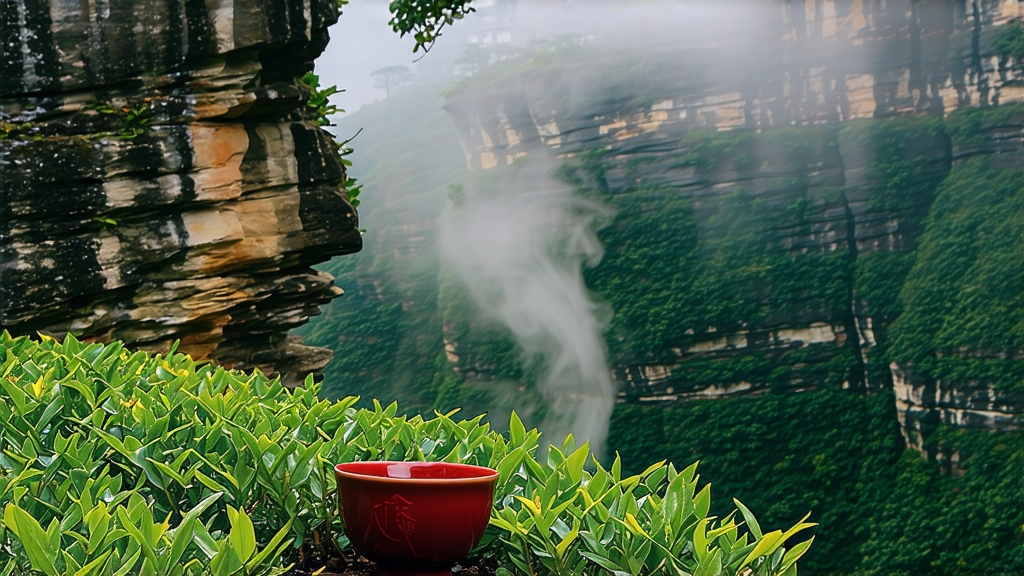
Ask any Chinese tea master to name one oolong that embodies both imperial legend and living terroir, and the answer is almost always Da Hong Pao—Big Red Robe—grown on the vertiginous basalt cliffs of Wuyi Mountain in northern Fujian. Unlike the floral green oolongs of Anxi or the honeyed cultivars of Phoenix Mountain, Da Hong Pao carries the taste of stone itself: a crystalline minerality that locals call “yan yun,” literally “rock rhyme.” To understand why this tea commands auction prices higher than gold, we must climb the mist-laden gorges of the Wuyi UNESCO reserve, trace 350 years of court records, and learn how a single leaf can be coaxed through six rounds of charcoal roasting without losing its delicate orchid aroma.
History: from imperial robe to national treasure
The most quoted origin story dates to the Ming dynasty (1368-1644). A passing scholar, en route to the capital for imperial exams, fell ill at the Tianxin Yongle monastery. Monks steeped leaves picked from four ancient bushes clinging to Jiulongke (“Nine-Dragon Cave”) cliff; the scholar revived, continued north, and placed first in the palace examinations. To express gratitude, he returned in crimson court robes and draped them over the tea bushes—hence “Big Red Robe.” Whether apocryphal or not, the tale secured imperial patronage; Qing archives list Da Hong Pao as tribute tea, transported 2,000 km to Beijing in sealed bamboo tubes lined with camphor leaves. In 1985, cuttings from those original mother trees—still alive at 350 years—were successfully propagated, giving rise to the modern “pure-clone” DHP market while the originals are now so protected that their yearly harvest of less than 200 g is stored in the state vault rather than sold.
Terroir: why cliffs matter
Wuyi’s Danxia landform, formed 100 million years ago, compresses iron-rich tuff and quartz into narrow terraces. Day-night temperature differentials of 15 °C force slow growth, while constant mist filters sunlight into soft, diffused rays. The roots penetrate fissures only 20–30 cm deep, absorbing mineral solutions that precipitate as the signature “rock rhyme.” Four micro-valleys—Niulanke, Huiyuankeng, Daokou, and Wuyuanjian—are traditionally judged “zheng yan,” or true cliff garden, commanding the highest prices. GPS readings show these plots between 200–500 m elevation on 60–80° slopes accessible only by narrow plank walkways bolted into the rock.
Cultivars: bloodlines of the red robe
Modern Da Hong Pao is a blend of three approaches:
- Qidan (“original seed”)—direct descendants of the mother trees, DNA-verified and grown inside the core reserve. Less than 500 kg reach market annually.
- Beidou #1 & #2—clones selected in 1962 from cuttings, prized for cold resistance and high catechin content.
- Mixed “pinpei” recipes—up to seven Wuyi cultivars (Rougui, Shui Xian, Tie Luo Han, Bai Ji Guan) combined by master blenders to recreate the balance of aroma, body, and lingering sweetness. Legally, any oolong produced within Wuyishan municipality may carry the Da Hong Pao name, but connoisseurs seek the zheng yan label plus the blender’s seal.
Craft: the nine-step cliff alchemy
- Picking: two leaves and a bud at 9–11 a.m. when dew has evaporated but sun remains soft. Standard is 4–6 cm length, 55–65 % moisture.
- Wilting: leaves are spread on bamboo screens set into rock crevices where canyon breezes lower moisture to 62 % within 90 minutes—faster than lowland oolongs, preserving greenness.
- Shaking: perhaps the most athletic step. Forty-pound batches are tossed vertically in rattan drums, bruising edges while keeping centers intact. Oxidation proceeds from 25 % to 35 %, the narrow band that yields amber liquor rather than brown.
- Fixing: wok-firing at 240 °C for 3.5 minutes arrests oxidation; masters listen for the “pop” of leaf veins bursting.
- Rolling